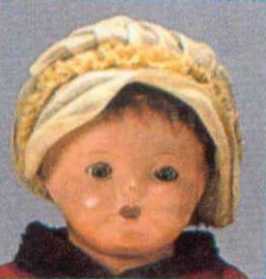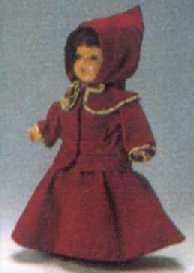Ambassadors of Friendship:
|
|
Each doll came with her own passport with her American name written on it, along with the name of her American donor. The dolls carried a message of goodwill reading: "Dear Children of Japan, I have come from faraway America. Please love me forever."
The dolls were distributed to primary schools all over Japan. Some were welcomed as state guests at the palace of the Imperial Family. As a return gesture of friendship, the children of Japan sent a group of their "Silent Envoys," wearing lovely silk kimonos and representing 58 cities in Japan, to the children of the United States. The dolls they chose were the "yamato ningyo" created around the turn of the century and designed to represent children of that era wearing the traditional kimonos. These dolls were originally made as gifts for royalty to present as honored gifts. Later "yamato ningyo" were also used as goodwill gifts. "Yamato ningyo," meaning simply "Japanese doll," today include boy and baby dolls and are commercially made. A beautiful doll titled Miss Japan was presented by the Imperial Family to the National Museum (the Smithsonian Institution) in Washington, D.C. Miss Japan is currently not on display, although it has been previously, and is kept under catalog number 340,126-69. As far as is known, there is no list available of the other dolls that were sent or where they found homes. What made the 1927 gift of dolls to Japan so unique was the magnitude of the enterprise, for it touched thousands of people and had surprising results. Most dolls that serve as Ambassadors of Goodwill end up in museums, respected and admired by those who view them. Such was not to be the fate of most of these American gift dolls. To understand what happened to these dolls and why it happened, one must look at the pages of history. Since 1637 Japan had been an isolated country. In the mid 1800s, Commodore Perry, backed up by the force of warships, dictated a treaty opening up American trade with that small island empire. This was followed by other nations also establishing trade with Japan. As a result, Emperor Mutsuhito urged his people to seek knowledge in all parts of the world to help make Japan strong. American experts in many fields were invited to help "Westernize" Japan. By the turn of the century people were becoming very aware of other countries and cultures beside their own. Dolls in national costume became very popular and many beautiful Oriental bisque-headed dolls were made by the German doll makers as part of "The Dolls of Four Races." In World War I, Japan, as an ally of England, declared war on Germany, and thus became our ally when we entered the war. With the supply of European made dolls cut off for the United States, Japan helped fill the void with their many copies of the German style dolls. Japan became one of the original members of the League of Nations in 1920 and strongly supported many measures for world peace. The 1924 Immigration Act excluded Japanese entry into the United States and was followed by other discriminatory immigration laws around the world. However, the desire of people throughout the world to prevent war FOREVER was very strong in the 1920s. The world was opening up as photography, telegraphy, radio, telephone, transportation and the motion picture industry aided communication between countries. Certainly efforts to help the children of the world understand each other were very commendable. The time was ripe for an overture of friendship between countries, such as the large gift of dolls from the United States to Japan. Travel to foreign countries, including the Orient, became very popular and souvenir dolls were desirable items as travel mementos. In the 1930s the United States had its own unofficial Goodwill Ambassador in the person of little Miss Shirley Temple. Her films, photographs and doll replicas were sent all over the world. This little live doll exemplified the perfect American child and children all over the world were aware of who she was. In Japan, a popular movie magazine filled two issues solely with photographs of her, without a single word of text and sold over two million copies. On her first visit to the Hawaiian Islands in 1935, Shirley made a special appearance at Iolani Palace to 30,000 of the islanders. Approximately one-third of the Hawaiian people are of Japanese ancestry. During this vacation, as a special token of their goodwill, Shirley was given about 60 dolls. The most noteworthy of these dolls was a life-size Japanese bride doll, presented to Shirley by a delegation of Japanese-descended Hawaiians. This doll had been purchased with pennies contributed by 20,000 Hawaiian-Japanese school children. The bride doll now resides at the Children's Hospital of Stanford University in Palo Alto, California. Over the years Japan supplied many dolls and toys played with and treasured by American children. Even the poorest children were familiar with the cheaply priced and crudely made small bisque and celluloid dollies that inhabited the doll houses and sewing baskets of their childhood. No matter if these small "Made in Japan" toys were lost, broken, smashed or squashed, because a few pennies and a trip to the local dime store would easily replace them. In the Japanese homeland, a burgeoning population and lack of natural resources made the expansion of the Empire very necessary. The aggressive action that the Japanese military leaders chose to accomplish their survival was understandably met with disapproval from many nations of the world. Relations between Japan and the United States steadily worsened. With the attack on Pearl Harbor in the Hawaiian Islands that fateful day in December 1941, the death knell to any cordial relationship was sounded. The Japanese people were our enemies and we were theirs. Propaganda and hate campaigns flourished to boost morale on both sides. When the tide of war turned in our favor in 1943, an order was issued that climaxed the Japanese "Hate America" campaign. The Goodwill dolls from America were ordered to be destroyed in public executions. The treasured dolls were dragged out onto school playgrounds, smashed, mutilated and burned -- the ultimate ritual of loathing for their enemy. It is a mute question to ask whether young school children really understood the significance of what happened. The teachers certainly did, but some dared to defy the order and secreted their school's dolls away. Just how many dolls survived this destruction did not come to light until the 1970s. One's initial reaction to such an act of brutality is shock. Looking realistically at our own annals of history, we find that many stories circulate about how, in the name of patriotism, Americans have vented their hatred of war and war makers on inanimate objects such as books and childhood playthings. During the First World War many fine foreign toys and dolls were relegated to cellars and storerooms, banned from sale in shops and stores across our nation, while we loudly proclaimed "American Toys for American Children." We hear reports of patriotic fathers smashing their children's foreign made toys as if the playthings would taint their children by association.
Because of the courage of some of the Japanese teachers, the true story of the Friendship dolls does have a happy ending. The war that bred hatred also bred renewed friendship. In 1973, a Japanese teacher by the name of Ayako Ishimaru happened to read a news report of an American doll treasured by a school in a city some 150 miles from Tokyo. Curious, she visited Kofu and found that indeed here was an American Friendship doll that had survived the massacre. This discovery began her quest to find out more about this doll and to uncover other such dolls. Aided by a committee that was formed to search out any information concerning these dolls, the final result was that 33 of the dolls surfaced. It is believed that more will come to light in the future. In August of 1978, to celebrate the 33rd anniversary of the end of the war between Japan and the United States, a very special exhibit was placed in the Mitsukoshi Department Store in Shinjuku, Tokyo, Japan. This display featured surviving Friendship dolls from America, their passports, photographs and old newspaper clippings, all assembled under joint flags of the United States and Japan. They had been lovingly gathered in the interest of everlasting Japanese-American friendship. Doll making is a serious business and a recognized art form in Japan. Japanese craftsmanship is influenced by centuries of tradition, religion and customs. One Japanese Buddhist belief is that dolls who have lived with their owners for some time acquire a soul and have a place in Nirvana, the afterlife or heaven. Today, in some places in Japan, old, broken or worn-out play dolls are cremated in a special ceremony during which the dolls' souls are transported to Nirvana. This custom is not followed for the Japanese Festival Dolls that are honored and revered, and passed on from daughter to daughter. Perhaps it does include the friendship dolls who were the tragic casualties of World War II. |

